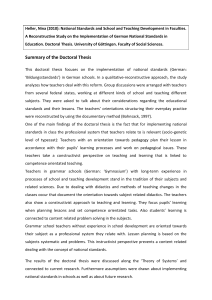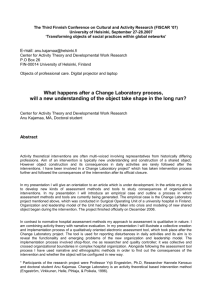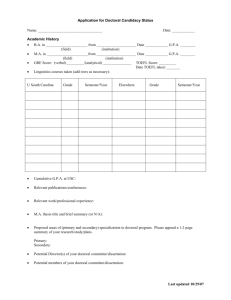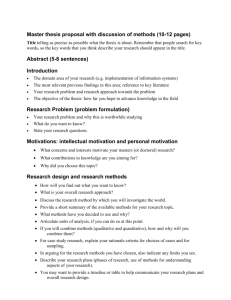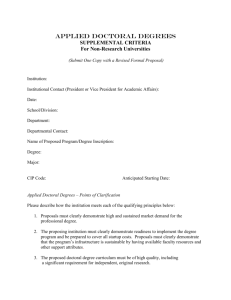How to write a summary of a dissertation
advertisement
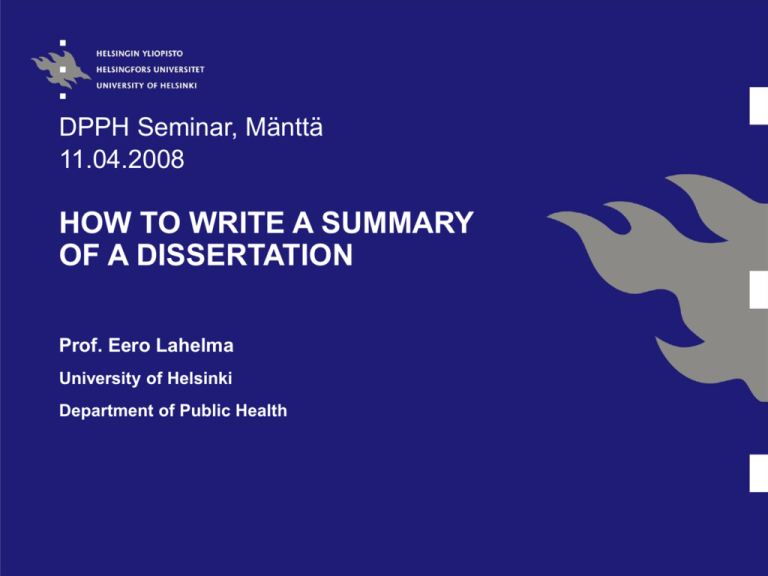
DPPH Seminar, Mänttä 11.04.2008 HOW TO WRITE A SUMMARY OF A DISSERTATION Prof. Eero Lahelma University of Helsinki Department of Public Health Background 1 Ongoing debate on doctoral studies Too many doctors? Quality of theses? Supervision, substudies/articles Good to look at doctoral work How it’s being done What are the expectations from students, supervisors, universities etc. How can we respond to the expectations How to avoid pitfalls, keep time schedules etc. Challenges for doctoral students and supervisors Statutes, guidelines, assessment, examples Experience from graduate schools – DPPH, VTE University of Helsinki as example Background 2 Writing a thesis Long process, serious effort, much research work Collaboration, supervision Reporting, writing, revising Thesis format Thesis based on articles + summary Monograph thesis Summary in focus No uniform guidelines Sometimes difficult, sometimes less so But it is summary! not another monograph Great variation between (even within) universities, faculties, departments Concentrate on (public) health sciences + related social and behavioural sciences What is a doctoral degree? Government decree on doctoral degrees 19.8.2004/794 22§ Passing a doctoral degree Tohtorin tutkinnon suorittamiseksi jatkokoulutukseen otetun opiskelijan tulee: 1) suorittaa jatkokoulutuksen opinnot; 2) osoittaa tutkimusalallaan itsenäistä ja kriittistä ajattelua; sekä 3) laatia väitöskirja ja puolustaa sitä julkisesti. … Väitöskirjaksi voidaan hyväksyä myös yliopiston riittäväksi katsoma määrä samaa ongelmakokonaisuutta käsitteleviä tieteellisiä julkaisuja tai julkaistaviksi hyväksyttyjä käsikirjoituksia ja niistä laadittu yhteenveto taikka muu vastaavat tieteelliset kriteerit täyttävä työ. Julkaisuihin voi kuulua myös yhteisjulkaisuja, jos tekijän itsenäinen osuus on niissä osoitettavissa. What is a doctoral thesis? - Faculty guidelines 1 Faculty of Social Sciences, Univ Helsinki (Väittelijän opas §1 7.11.2007): ”Väitöskirja on tieteellinen, itsenäiseen tutkimukseen perustuva monografia tai artikkeliväitöskirja, jossa esitetään uutta tietoa.” Faculty of Medicine, Univ Helsinki (Tieteellinen jatkokoulutusopas, yleiset määräykset väitöskirjasta): ”Väitöskirjan voi esittää joko osajulkaisuväitöskirjana, jossa on yhteenveto-osa ja liitteenä osajulkaisut tai monografiaväitöskirjana.” Write a thesis on substudies or write a monograph? Thesis based on substudies Sub-questions – many substudies Article format - typically in English Publishing – requires effort Broader audience – summary? Feedback - research community Joint work – except summary Monograph Unpublished ms – no articles One question, one data source Theoretical or qualititative emphasis In Finnish – national significance One (heavy) work process What is a doctoral thesis? - Faculty guidelines 2 Faculty of Medicine, Univ Helsinki Doctor of Philosophy, Doctor of medicine Re: Doctoral thesis based on substudies A thesis contains several substudies following a coherent theme plus a summary by the doctoral student which is the proper thesis. The student has to have a clear independent contribution in joint substudies. Substudies have to be published (or accepted) in high quality scientific series or journals, except one which can be unpublished. Summary can include unpublished results. What is a manuscript? Faculty guidelines Faculty of Medicine, Univ Helsinki The following parts are included in a doctoral thesis Abstract, 1–2 pages on the doctoral work and its main results Analytic literature review, which shows the knowledge within the field, its development and current status (I = Introduction) Research questions of the study. A presentation of data and methods. (M = Methods) Results of own study and their discussion. (R = Results) (A = And) General discussion where own results are critically compared with previous studies. Summary and conclusions. List of references. (D = Discussion) ”IMRAD” How are manuscripts assessed? - Faculty guidelines for reviewers of doctoral theses (pre-examiners) Faculty of Medicine, Univ Helsinki Following points should be apparent from the review: 1. Originality of the research, basic idea and previous work in the field. 2. Planning the research to follow rules of science. 3. Reliability of methods. 4. The way results are reported. 5. Brief presentation results achieved. 6. Adequacy of discussion (without unnecessary speculation). 7. The structure of the work, title and subtitles. 8. Knowledge of literature of own field. 9. Coherence formed by substudies. Own contribution by the doctoral student in palnning and accomplishment of the study. How does the extent of summary vary? - Public health, Univ Helsinki 38 theses in 1998-2007 (medicine-other fifty-fifty) Summary + 3-7 substudies Gross number of pages in summary Range 41-131 Over 100 10 75-99 14 50-74 13 Below 50 1 Average 89 Theses with over 100 pages increasing? Layout (1 or 2 columns), tables/figures, literature, appendices affect the length What is the nature of summary and its contents? 1 ”Yhteenvetoon väitöskirja tuskin koskaan kaatuu” (Isohanni 2000) No clear rules - a summary of the substudies Article, report, summary, something else? Guidelines for exminers, previous works within own field Own work as part of current research – what’s the contribution Extent ca. One substudy or + 15-20% - good ≠ long Publishing, language Nature of summary – disciplinen and their traditions ”Coherent theme” – framework Independent text – do not copypaste! Summary tables/figures: literature review + results Possible additional results (not in substudies) Critical, analytic, summarising, broader, more abstract perspective than in single substudies, esp. discussion Quality and extent At best deepens the theme and the interpetation of results High quality substudies – less empahsis on summary, modest substudies – more emphasis on summary (?) Good summary may produce a review article What is the nature of summary and its contents? 2 Summary of pitfalls Start too late Too concise – too long Problems of structure No framework vs. too broad scope? Literature review - too broad, lack critical/analytic approach Methods inadequately presented Results directly copied from articles? Discussion copied from substudies Discussion over the whole work lacking Unbalanced Problems of text Copypaste from articles Tables, figures? Discussion Independent text – copyright What do reviewers empasise in their comments on summaries? Review typically follows The structure of the work (IMRAD) or faculty guidelines Emphasis on summary as a description of the work done Research questions and themes, importance and novelty Adequacy of accomplishment of research and results Quality of summary with regard to substudies Structure of work = substudies as a coherent whole Coherence, ”logical wholeness” Significant findings and novelty important Literature review Extent, boundaries rajat, systematic Concepts/framework Knowledge of own field, ”critical” Methods ”Adequacy” Discussion Interpretation, ”maturity”, avoiding speculation Jaana Lindström: Prevention of type 2 diabetes with lifestyle intervention – emphasis on dietary composition and identification of high-risk individuals. (2006) LIST OF ORIGINAL PUBLICATIONS.............................................................................11 ABBREVIATIONS.............................................................................................................12 1 INTRODUCTION ....................................................................................................13 2 REVIEW OF THE LITERATURE ..........................................................................15 2.1 Definition of type 2 diabetes and other categories of glucose intolerance................15 2.2 Epidemiology and pathophysiology of type 2 diabetes ............................................18 2.3 Risk factors for type 2 diabetes.................................................................................19 2.3.1 Obesity ......................................................................................................20 2.3.2 Diet composition .......................................................................................26 2.3.3 Physical inactivity .....................................................................................32 2.3.4 Other lifestyle factors................................................................................32 2.4 Previous lifestyle intervention studies to prevent type 2 diabetes ............................32 2.4.1 The Malmö feasibility study .....................................................................33 2.4.2 The Da Qing IGT and Diabetes Study ......................................................33 2.5 Identification of target groups for intervention.........................................................35 2.5.1 Rationale for screening .............................................................................35 2.5.2 Methods for screening...............................................................................38 3 AIMS OF THE STUDY ...........................................................................................41 4 POPULATIONS AND METHODS .........................................................................42 4.1 Diabetes Prevention Study (Papers I - IV)................................................................42 4.1.1 Population and design ...............................................................................42 4.1.2 Lifestyle intervention ................................................................................45 4.1.3 Assessment of dietary intake.....................................................................46 4.1.4 Assessment of physical activity ................................................................47 4.1.5 Assessment of compliance with the intervention goals.............................47 4.1.6 Clinical examinations................................................................................47 4.1.7 Laboratory analyses ..................................................................................47 4.1.8 Assessment of the end-points....................................................................48 4.1.9 Statistical methods ....................................................................................48 4.1.10 Project organisation...................................................................................49 4.2 Diabetes risk score (Paper V) ...................................................................................50 4.2.1 Populations and design..............................................................................50 4.2.2 Assessment of the end-points....................................................................50 4.2.3 Statistical methods ....................................................................................51 Jaana Lindström (2) 5 RESULTS.................................................................................................................52 5.1 Diabetes Prevention Study (Papers I - IV)................................................................52 5.1.1 Baseline results .........................................................................................52 5.1.2 Intervention results....................................................................................54 5.1.3 Post-intervention follow-up results ...........................................................64 5.2 Diabetes risk score (Paper V) ...................................................................................69 5.2.1 Model development...................................................................................69 5.2.2 Model validation .......................................................................................69 5.2.3 The Finnish Diabetes Risk Score FINDRISC ...........................................72 5.3 FINDRISC in the DPS population............................................................................73 6 DISCUSSION...........................................................................................................75 6.1 Prevention of type 2 diabetes....................................................................................75 6.1.1 Diabetes incidence ....................................................................................75 6.1.2 Changes in lifestyle...................................................................................77 6.1.3 Changes in body weight and clinical variables .........................................77 6.1.4 Determinants of changes in body weight and type 2 diabetes risk............78 6.1.5 Limitations ................................................................................................83 6.2 Identification of high-risk individuals.......................................................................85 6.3 Practical implementation of the findings ..................................................................88 7 CONCLUSIONS ......................................................................................................91 ACKNOWLEDGEMENTS.................................................................................................92 REFERENCES ....................................................................................................................94 APPENDIX ORIGINAL PUBLICATIONS Yht. 125 s. Akseli Aittomäki: Social class inequalities in ill health – the contribution of physical workload List of original publications 7 Abstract 8 Tiivistelmä 9 Chapter I Introduction – the issues of work and class inequalities in ill health 10 Chapter II Social stratification and class theory 15 Classical Marxism 16 Contradictory class locations – Marxism of Erik Olin Wright 18 Class as market situation in Max Weber’s theory 19 Liberal theories on industrialisation and status attainment 20 Service class versus the labour-contract – John Goldthorpe’s position 22 Operationalising class 23 Chapter III Social class and public health – from history to explanation 25 Early social medicine and class 26 Official statistics and class 29 Social stratification in epidemiology today – comments on Lynch and Kaplan 30 Explanations to inequalities in health 32 The structural framework of explanation 33 Materialistic explanations 34 Psychosocial explanations 36 Lifestyle explanations 38 Selection and mobility 39 Emerging complexity – and a simple strategy 41 Chapter IV Concepts of health and illness 43 Health as a variant of goodness – the philosophy of Georg Henrik von Wright 44 Disease as a medical concept 45 The Parsonian sick role as an approach to social meaning of illness 47 Medical, experienced and social dimensions of health – the three model approach 48 Measuring illness and morbidity 49 Functioning as a quantity of illness 51 Chapter V Conceptualising workload 52 A model of mechanical exposure 53 Description of physical workload as a pathway 54 Relationship to stressor-strain concept 56 Demands and decision latitude – the model by Robert Karasek 57 Chapter VI Previous research – a review of relevant empirical studies 59 Class inequalities in overall physical morbidity 59 Socioeconomic inequalities in major disease groups 61 Work disability and social class 64 Social class inequalities in functioning 66 Physical workload in the population 67 Physical workload as a determinant of musculoskeletal disorders 70 Decision latitude as determinant of ill health and class inequalities in ill health 73 Physical workload as an explanation for class inequalities in ill health 75 Chapter VII Scope and objectives of the study 82 Chapter VIII Methods used in the study 84 On the City of Helsinki 84 Mail questionnaires 85 Health examinations 86 Personnel registers and combined data 87 Social classification 88 Measures of ill health and functioning 89 Measures of physical work conditions 92 Other measures 95 Statistical methods 95 Elaboration of effect mediation 97 Chapter IX Results of the study – statistical models of effects of social class and work conditions on ill health 99 Dependence on gender, age and decision latitude of the effect of physical workload on limited functioning 101 The contribution of physical workload to class inequalities in ill health and limited functioning 102 Chapter X Discussion on the findings and methods 106 Contribution of physical work load to social class inequalities in ill health 107 Interaction of physical demands with decision latitude, age and gender 110 Causality of the observed effects and potential influences from selection 111 Issues of social classification 113 Measures of work conditions 115 Measures of ill health 117 Data collection and statistical methods 120 Generalisability of the findings 122 Conclusions 124 Acknowledgements 126 Bibliography 128 Original publications 146 Literature, statutes, guidelines Eco Umberto. Oppineisuuden osoittaminen eli miten tutkielma tehdään. Vastapaino, Tampere 1989 Isohanni Matti. Monografia vai osajulkaisuväitöskirja? Duodecim 1998:114:376-378 Isohanni Matti. Väitöskirjan yhteenveto-osa – väkisin väännetty vai työn kruunaus. Suomen Lääkärilehti 2000:55:3366-3369 Patja Kristiina ym. (toim.). Kohti karonkkaa. Kustannus Oy Duodecim 1999 HY:n lääketieteellinen tiedekunta: www.med.helsinki.fi/opiskelu/tieteellinen jatkokoulutus/opintoopas Valtioneuvoston asetus yliopistojen tutkinnoista 19.8.2004/794: www.edilex.fi/saadokset/lainsaadanto/20040794 Valtiotieteellinen tiedekunta: www.valt.helsinki.fi/jatko-opinnot/väittelijän opas
